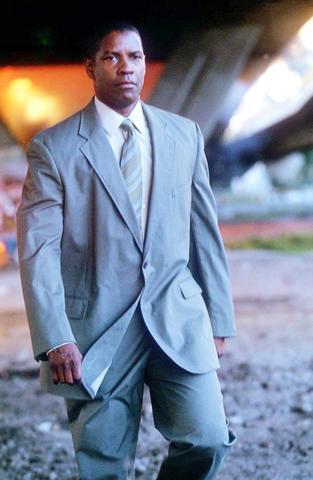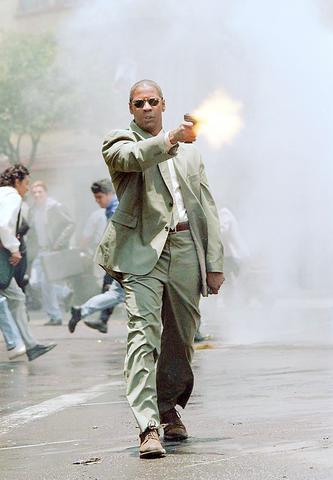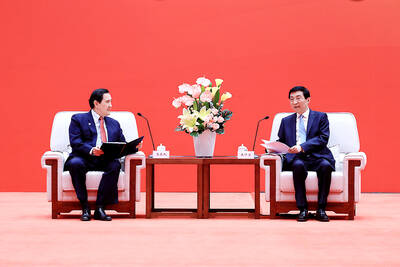Man on Fire is a new child-endangerment thriller starring Denzel Washington, a film that will raise the blood lust aroused by Kill Bill: Vol. 2 and The Punisher.
Like those two movies, Man on Fire, directed by Tony Scott from a script by Brian Helgeland, is about the grim duty (which is to say the gory pleasure) of vengeance. The first act, a moody, foreboding adventure in high-risk baby-sitting, exists to provide a moral and emotional pretext for the blood bath that follows. John Creasy (Washington), a veteran of some kind of too-secret-to-mention military operations, drifts down to Mexico in a depressive alcoholic haze. With the help of an old war buddy (Christopher Walken), he is hired as a bodyguard by a wealthy couple in Mexico City who worry that their young daughter, Pita (Dakota Fanning), will become the target of kidnappers.

PHOTO COURTESY OF FOX MOVIES
Needless to say, she does. But first her precocious cutie-pie spunkiness softens Creasy's morose demeanor. Initially resistant to her overtures, he eventually becomes her swimming coach, homework tutor and all-around best pal, while her parents (Marc Anthony and Radha Mitchell) skulk away on mysterious trips. Washington and Fanning (who played Sean Penn's daughter in I Am Sam) are both instinctive stereotype-smashers and their easy, skillful rapport gives the

picture's sentimental first half more credibility than it deserves.
Scott, meanwhile, with his characteristic blend of cynicism and heavy-handedness, infuses even the quietest moments with nerve-jangling dread. His fondness for intrusive, fake-stylish camera tricks -- jump cuts, speeded-up montages, abrupt changes in light, color saturation and focal depth -- has overwhelmed whatever story sense he once possessed.
This time, like an art student discovering, a decade too late, that it's cool to incorporate text into images, he flashes subtitles across the middle of the screen, in a variety of sizes and type faces, not only translating the Spanish dialogue but also spelling out some choice lines of English as well.
This is mystifying, but also typical of the garish, extravagant
literal-mindedness that governs A Man on Fire. Once little Pita is snatched, in slow motion and a hail of bullets, from her piano lesson, the only question is whether this will be a story of rescue or of revenge. It doesn't really matter, since the bad guys will get their grisly comeuppances in either case.
Washington, lumbering into action-hero mode, trades in his nuances for shotguns, grenade launchers and other heavy weapons as well as less explosive but nonetheless useful tools of the trade, like duct tape and a folding knife.
"He's an artist of death," says Walken, whose character has sworn off killing, "and he's about to paint his masterpiece."
And so Creasy, with minimal suspense and maximum sadism, goes after the kidnapping ring that terrorizes Mexico City. He is helped by a crusading journalist (Rachel Ticotin) and her sometime lover, the city's only honest law enforcement agent (Giancarlo Giannini). As Creasy wades into battle, images of Pita flash before our eyes, her innocent sweetness both a pointed contrast to the depravity of her abductors and a justification for their agony.
This is a time-tested movie con, but rarely has it been deployed so contemptibly. You can relish the sight of a lowlife's fingers being amputated one by one, his wounds cauterized by a dashboard cigarette lighter without guilt because, after all, he was involved in harming a child. And if you object, then you're not only some kind of wishy-washy due-process wimp, but you also probably condone the kidnapping of little girls. (Scott, for his part, shows a borderline creepy fondness for filming them in bathing suits.)
"Kill them all," Pita's mother hisses when she learns of Creasy's plan. In the same scene we learn that she has been reading his Bible, a book he consults and occasionally quotes, though it may be a different version than the one I'm familiar with. I've combed through both testaments, and I can't find the verse that seems to be Creasy's favorite -- the one that says: if your enemy smites you on one cheek, rig a tube full of plastic explosive to his body, tie him to the hood of a car and light the fuse.

The canonical shot of an East Asian city is a night skyline studded with towering apartment and office buildings, bright with neon and plastic signage, a landscape of energy and modernity. Another classic image is the same city seen from above, in which identical apartment towers march across the city, spilling out over nearby geography, like stylized soldiers colonizing new territory in a board game. Densely populated dynamic conurbations of money, technological innovation and convenience, it is hard to see the cities of East Asia as what they truly are: necropolises. Why is this? The East Asian development model, with

Desperate dads meet in car parks to exchange packets; exhausted parents slip it into their kids’ drinks; families wait months for prescriptions buy it “off label.” But is it worth the risk? “The first time I gave him a gummy, I thought, ‘Oh my God, have I killed him?’ He just passed out in front of the TV. That never happens.” Jen remembers giving her son, David, six, melatonin to help him sleep. She got them from a friend, a pediatrician who gave them to her own child. “It was sort of hilarious. She had half a tub of gummies,

The wide-screen spectacle of Formula One gets a gleaming, rip-roaring workout in Joseph Kosinski’s F1, a fine-tuned machine of a movie that, in its most riveting racing scenes, approaches a kind of high-speed splendor. Kosinski, who last endeavored to put moviegoers in the seat of a fighter jet in Top Gun: Maverick, has moved to the open cockpits of Formula One with much the same affection, if not outright need, for speed. A lot of the same team is back. Jerry Bruckheimer produces. Ehren Kruger, a co-writer on Maverick, takes sole credit here. Hans Zimmer, a co-composer previously, supplies the thumping

There is an old British curse, “may you live in interesting times,” passed off as ancient Chinese wisdom to make it sound more exotic and profound. We are living in interesting times. From US President Donald Trump’s decision on American tariffs, to how the recalls will play out, to uncertainty about how events are evolving in China, we can do nothing more than wait with bated breath. At the cusp of potentially momentous change, it is a good time to take stock of the current state of Taiwan’s political parties. As things stand, all three major parties are struggling. For our examination of the